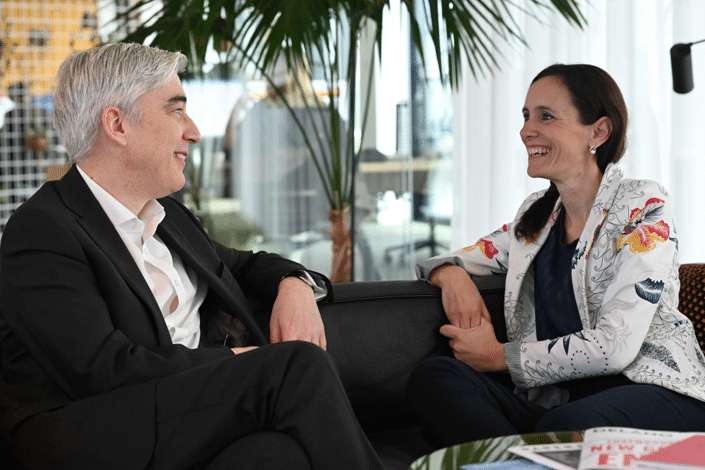FUND DISTRIBUTION AND BLOCKCHAIN
Frank Roden : Welcome. You are listening to BNP Paribas’ “Thinking Aloud” podcast series.
I am Frank Roden, Head of Asset Owners and asset managers EMEA for the Securities Services business of BNP Paribas. I am pleased to be joined today by my colleague Carole Michel, Senior Product Manager for Fund Distribution. Welcome Carole.
Carole Michel: Hi Frank, and thank you.
What can asset managers expect from blockchain technology?
Frank: in this episode, we want to dive into blockchain technology and explore with you how it could foster change in the world of fund distribution.
We know that asset managers expect a great deal from this technology.
- They want to reach new investors ready to fully embrace digital solutions. Through the blockchain, digital distribution platforms should allow asset managers to directly sell their funds across the world, for instance by capturing new savings from investors in emerging markets. But that’s not the only benefit the technology could offer.
- Integration is the other benefit that blockchain technology could bring about. A streamlined distribution chain means a more efficient process, reducing costs for asset managers and their transfer agents
Surely, these are bright prospects for asset managers. But there is still a long road ahead of us. So, let’s start with the beginning.
Impacts of the blockchain on fund distribution
Frank: Carole, what can you tell us about DLT, or Distributed Ledger Technology? We know that the blockchain is one of the most common forms of DLT, but how could it transform fund distribution?
Carole: There are two key components of the blockchain:
- First, the distributed ledger allows each participant of the blockchain to have access to the same data in real time.
- Secondly, the activity happening on the blockchain is underpinned by “smart contracts”, or automated applications
If you look at those two components in the context of fund distribution, the blockchain could in fact lead to a simpler, faster and cheaper ecosystem with peer-to-peer transactions.
DLT examples for fund distribution and transfer agency
Frank: in the short-term, how will the blockchain impact the operational set-ups of funds?
Carole: today, the blockchain is mainly used to distribute and/or issue shares in a fully digitalised way.
In France, some asset managers are already appointing DLT platforms to distribute and issue native tokens. This DLT platform becomes the transfer agent of the DLT shares. So, the blockchain is the golden source, provides one version of trust and provides also proof of ownership to all participants of the network.
At Securities Services in Luxembourg, we are experimenting with a live use case on tokenized securities. So we are using the DLT platform on the buy side to place the orders on the blockchain, but also on the transfer agent side to capture and confirm orders. So we improve the order management by, for example, removing the official contract note report, that we send to the investor. So let’s say that the blockchain is a new communication channel with the investor. However, as a first step, we are still capitalising on the current legacy systems to manage part of the order cycle.
So many tasks remain off chain like, for example, the settlement instructions, the reconciliations or the AML/KYC[1]. Indeed, all participants, all stakeholders would need to be involved to unlock the true potential of the technology. For example, the fund administration: we need to be involved to perform the reconciliations of the positions, or custodians can be participants of the blockchain to manage the cash on chain.
Frank: And Carole, you just mentioned cash. How do you expect that blockchain technology will impact cash?
Carole: we think that this technology could allow asset managers to increase the liquidity of their funds. With cash being represented on the blockchain, security tokens would be exchanged in real time against cash tokens. The process could be fully DVP, fully delivery versus payment, reducing the settlement cycle to potentially T0 and reducing counterparty risk. There would no longer be any need for contractual settlement or cash reconciliations to chase potential unpaid subscriptions.
DLT efficiency or DLT complexity?
Frank: so, DLT could bring more efficiency to fund distribution in the long term. Asset managers adopting DLT models want to reduce transaction costs for their investors by avoiding intermediaries.
However, today, it seems to me they face a paradox. Opting for a DLT model brings them more complexity actually. So, how do we solve for that paradox?
Carole: in France, our clients are currently distributing and issuing an ISIN[2] via Euroclear with us as a “traditional transfer agent”, but at the same time they are also distributing and issuing the same ISIN with an external DLT platform which actually becomes the “blockchain transfer agents” for this DLT shares. So, with two transfer agent providers, it is more expensive and more complex for the asset manager.
This is why Securities Services at BNP Paribas invested to aggregate the orders coming from these DLT platforms in an open architecture model. We think that both distribution processes – DLT digital and traditional shares- will have to run in parallel for a number of years.
So, in France, we are currently already supporting our clients, as transfer agent, because we are collecting the DLT orders from these new providers. We integrate these orders in our legacy systems like any other orders. And then we are able to provide a consolidated view on the cash flow forecast for example to the asset manager. We are also able to provide their fund administration or their depositary bank with the total number of shares in issue. And we are also able today to manage and to settle the cash of these DLT orders.
Frank : you have just described the French model. But, are there other models for transfer agency, aside of the French one that you just talked about?
Carole: yes, existing transfer agents will have to adapt to manage both types of issuances. So, this is why in Luxembourg we are experimenting with this hybrid issuance. So we propose to remain the unique transfer agent of the Fund. And the client is not obliged to subscribe directly to the DLT provider, because we propose to represent our clients on the blockchain. We propose to represent our transfer agent clients but we can also represent the investors dealing funds to place the orders on the blockchain or manage the wallet of the investors.
DLT use cases with asset managers
Frank: and talking about clients, do you find that the clients really ready to experiment with this technology with us?
Carole: yes, as an example, we have one Italian client managing funds in Luxembourg and experimenting with us this new technology. And for this experimentation, we are collaborating with Allfunds Blockchain and the objective is to test the efficiency of the DLT and facilitate the stock transfer between shares. So meaning that both investors can exchange their tokens directly on the blockchain
We are also discussing with many of our strategic clients in multiple jurisdictions. And, what we can say is that they want mainly to experiment this technology. But we expect of course the volume of blockchain transactions to increase in the near future. Asset managers aim to widen their distribution networks and attract new type of investors.So they need a provider, like us, who will enable a smooth transition to a more mature model.
Frank: how quickly do you see this happening?
Carole: of course, it will take time. Thanks to our global reach and local expertise, we are already involved in and are participating to several initiatives in France, Luxembourg, Germany and also in Singapore. And we can say that markets move at different paces.
We are confident that this technology can bring value and efficiency with these new way to distribute and issue a share- for our clients-. This is why we are investing in this technology in upfront research and IT development to accompany our clients.
Frank: I have one final question: what, in your view, is the main advantage of the partnership model we are currently experimenting with?
Carole: at BNP Paribas, we believe in the concept of a marketplace, a network open to all stakeholders This would bring multiple benefits, for example:
- Investors could have a single point of entry and have access to multiple transfer agents within the blockchain network.
- Asset Managers could capitalise on the network to connect to more investors
- Transfer agents could potentially mutualise tasks like the collection of investors’ data
This might significantly transform the industry!

Frank Roden and Carole Michel
Frank: so, this might significantly transform the industry! What a great place to stop, Carole. Thanks so much for sharing your insights on the blockchain and the world of fund distribution. This has been a BNP Paribas Thinking Aloud podcast. I hope you found it as interesting as I have, and please do have a look at the other similar podcasts available on our website.
Thank you for joining us.
[1] Anti-Money laundering/Know Your Client
[2] International Securities Identification Number
You may also like
Hedge funds explore the next big distribution opportunity
With the right administrative support, there’s no reason why retail market can’t be an exciting new source of opportunity for hedge funds.
Fund distribution: reducing complexity
Fund buyers and fund distributors face an unprecedented level of choice. What are the recent trends in cross-border distribution and solutions to increase efficiency?
DLT Pilot Regime regulation memo
The DLT Pilot Regime is a key pillar of the European Union’s digital finance strategy.
Related solutions
Transfer agent and fund distribution services
We deliver secure yet flexible services to efficiently manage international fund distribution
Global fund dealing services – Fund@ccess
Amidst a changing investor base and a pressurised cost environment, it is more important than ever for asset owners to be able to buy and service funds efficiently.
